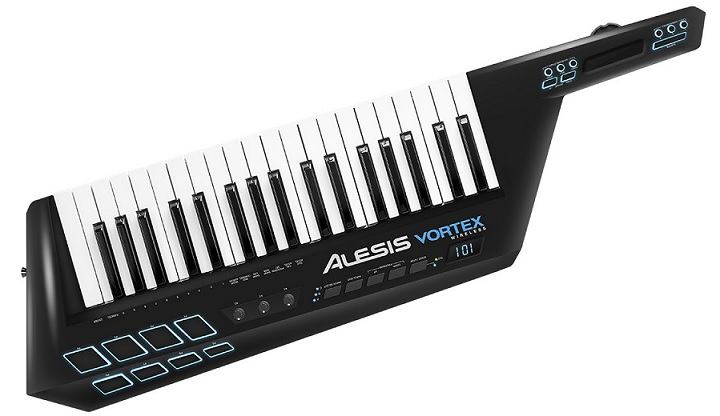
Alesis Vortex Wireless 2 Keytar Keyboard Controller sends MIDI wirelessly so that you play rock software synths on stage without any wires dangling out from the keytar. 37-Keys, on-board control and connectivity,
battery-powered, USB/Midi jack, production software package. Check price on zZounds
Alesis Vortex Wireless Keytar: Highlights
- Lightweight and low-profile, makes it easy to wear on the shoulder
- Has all the useful controls you need, right where you need them to be
- USB and MIDI outputs allows it to work with all your gear (including iOS devices)
Alesis Vortex Wireless Keytar: Pros & Cons
- Pros: Value-for-money. Easy to setup. No latency . Good range of the wireless transmitter. Lightweight. Amazing Battery life. Nice ergonomics. Well placed controls/buttons.
- Cons: Takes some getting used to. Make sure the shoulder strap is fastened securely to the Keytar. Drum pads require too much pressure. Software does NOT ship with the unit, it needs to be downloaded from the site
- Uses: Use it to augment your existing keyboards for live performance (using a computer). Add mobility and a WOW factor to your performance.
You will love this keytar if you understand midi interfacing with a computer midi software or iOS midi apps.
Alesis Vortex Wireless Keytar: Review
One of the best things about the Alesis Vortex Keytar is that its wireless (in addition to the many more features) and its super-affordable, considering that this is going to be used only be experienced musicians.
Imagine lying down on the couch, watching tv, ad playing it like a guitar. Despite the cheap price (around $200), it’s pretty sturdy, pretty and well made.
Lightweight and low-profile design
Weighs under seven pounds, without compromising a bit on the control or feel. You can run the Vortex Wireless on USB bus power, DC adapter (sold separately), or even four AA batteries.
All the controls easily accessible
You have a wide selection of controls at your fingertips.
37 keys with aftertouch control. Eight velocity-sensitive drum pads let you tap out rhythms and trigger loops, plus the Vortex Wireless features a full transport section for running your DAW.
Up at your left hand, there’s a volume slider, a pitch wheel, and an assignable touch strip.
There’s even an accelerometer built into the body, so you can control modulation and other parameters by merely tilting your Vortex Wireless as you play.
Most users use this Keytar to control a stationary keyboard wirelessly (in the studio or onstage). They use a usb-to-midi conversion box where they plug the dongle into, then feed output from the box into the midi-in port of the stationary synth.
USB and MIDI outputs
5-pin MIDI output port and a fully class-compliant USB port, which gives you plug-and-play computer connectivity. The MIDI-over-USB port is also CoreMIDI compatible, so you can hook it up to your iPad and tap into a world of amazing iOS music apps.
Whether you use a MIDI keyboard or a computer running virtual instruments for your sounds, the Vortex Wireless controller will integrate perfectly with your synth rig.
Overall Design
Once strapped on, you can easily access the keys, buttons, and pads. The pitch wheel, octave up/down, and ribbon controller are placed in the “neck” and are easy to access.
You get traditional MIDI cable as well as USB for ‘plug-n-play’ operation. Simply plug in your Keytar and hit the keys.
Operation & Design
The Keytar functions as you would expect it to. The keys are nice (not weighted). The vortex has a solid switch that toggles between “BATT”(battery), “OFF”, “USB”, and “DC” (adaptor).
Alesis Vortex Wireless Keytar: Demo / Video Review
Watch: Alesis Vortex wireless 2 keytar Controller Demo
Alesis Vortex Wireless Keytar: Features
Features:
– USB dongle creates a wireless connection to any Mac or PC
– 3-octave keyboard. 37 velocity-sensitive keys with aftertouch. Solid, plastic keys with nice response and feel.
– 3 digit LCD screen
– USB and traditional MIDI jacks for use with any synth, sound module, or other MIDI hardware or software
– Embedded, programmable, MIDI-assignable accelerometer for performance parameter control by tilting the neck
– Thumb-controlled volume slider and pitch-bend wheel on neck
– Finger-controlled MIDI-assignable touch strip, sustain, and octave-control buttons on neck
– 3 assignable knobs & lights & pads for program/patch control
– Octave up, down, keyboard lower, upper & split tactile buttons within easy reach of left hand (middle to pinky) fingers.
– Solid tactile rubber-covered pitch wheel, perfectly placed for thumb use & control
– Assignable slider that can be controlled by thumb or finger
– 8 velocity-sensitive drum pads/sample triggers enable you to create beats or trigger clips
– Powers up with batteries, USB bus, or DC power adapter
– Large transport (Start/Stop) and patch-select controls for instant access
– Class compliant USB-MIDI I/O
– Standard guitar strap pegs on neck and body (strap included)
– Make music out of the box with a free Sonivox virtual synth, AIR Music Tech Ignite software, and Ableton Live Lite Alesis Edition
– Ships with a USB wireless receiver, USB extension cable, USB cable, 4 AA batteries, strap, and cable harness
– Dimensions: Height 2.2″, Width 35.1″, Depth 10.6″, Weight 6.5 lbs.
Premium Software Suite Included – World-class production software package included: Hybrid 3, Loom 2, Vacuum Pro, and Xpand!2 by AIR Music Tech, TimewARP 2600 by Way Out Ware, and Ableton Live Lite
Buying Links & Pricing
Overall, a cool Keytar with nice looks and useful features, there’s no way you will regret buying it. The Alesis Vortex Keytar is much cheaper compared to the price of similar products by similar manufacturers (i.e. Roland, Yamaha, etc).
Checkout more keytars here.
KeytarHQ editorial team includes musicians who write and review products for pianists, keyboardists, guitarists & other musicians. KeytarHQ is the best online resource for information on keyboards, pianos, synths, keytars, guitars and music gear for musicians of all abilities, ages and interests.



Its cheap, but then you get what you pay for.
The concept is very good, and the controls provided are great. But the keyboard feels like one from those keyboards you buy at the toy store.
The key throw is too long, not professional, the feel is terrible. I had to insert a thick band of those insulating rubber strips for doors and windows you buy at the hardware store underneath the keys to shorten the key travel. This improved the feel a bit.
The reason the keyboard feels so cheap is that the spring action on the keys comes from bending a plastic segment at the top of each key, where it attaches to the frame.
To me, a keyboard like this, meant to be played hanging from your shoulder, should have a much shorter action like an accordion and sturdier construction. If this thing had a more professional keyboard it would definitely be a great stage tool.
If you need a shoulder-held rig like this, you can’t beat the price, and the left hand real-time controls and additional knobs and pads are wonderful. But its challenging to deal with the keyboard for live playing and your playing will suffer.